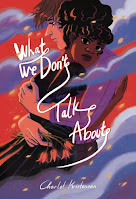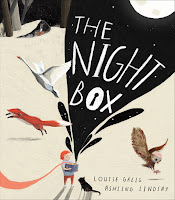We all know that helpful maxim "Don't judge a book by its cover." And we all know that graphic novels are the exception, right?? RIGHT??! After all, they give you a glimpse of the art that will either make or break the book. That quick look at the art style (via the cover) is often the thing that will prompt me to pick a book up at all. When I first saw the fabulous colors and cover art of Charlot Kristensen's young adult graphic novel What We Don't Talk About on Twitter it immediately snagged my attention and prompted me to pre-order (and I'm not mad about it!).
Farai has been in a relationship for two years and has never met her partner’s parents. Until this weekend.Farai has finally persuaded Adam to introduce her to his parents, but the visit to the in-laws turns out to be a horrible experience for her. She starts to feel uneasy and ostracised. When confronted about this experience Adam tries to play down the situation and does not show any understanding for his partner's concerns. Then things get a whole lot worse and Farai has to question if she can be with a man whose family does not accept her and who is not willing to face the difficulties related to an interracial relationship.
Examining contemporary issues of race, bigotry and the difficulties that interracial couples face, What We Don't Talk About is an exciting debut from a burgeoning talent and important new voice in graphic fiction.
Farai has been with Adam for two years, and thinks it's well past time that she met her boyfriend's parents. When they take a weekend trip to meet them, though, something immediately feels off. What is going on with his mom and her insensitive comments? When does insensitivity turn the corner into bigotry and racism? Why is Adam closing himself off and ignoring her ? In this contemporary comic, Farai will need to confront microaggressions (and just plain aggression), stereotyping, and decide whether she can live with what she knows now... or if she needs to make a change.
In What We Don't Talk About, Kristensen spins a story about, quite literally, the things we don't talk about: family tensions exacerbated by abuse and/or just plain unrealistic expectations, hidden (and more overt) bigotry, the pressure placed on people of color when they must decide between calling someone out on their racism and/or "keeping the peace," and the inevitable relational fallout when partners disappoint you – times one thousand, because gaslighting. While it might not be the most complex of narratives, Kristensen's storytelling has excellent pacing and keeps tensions ratcheting higher and higher. This book has the feel of a thriller, with several moments where as a reader you can't tell if a scene will devolve into actual violence. That alone would make the story a standout, but add in truly delicious art, and you have a bit of magic.
And about that art! Kristensen's style avoids outlines and is layered with color and brush texture (from, I'm assuming, a digital medium). It is also full of light: each scene's light source throws gorgeous shadows on the characters, and the effect is colorful and subtle at the same time – gradations of light can add to the tension and mood, or diffuse it. The art was truly the thing that drew me to this comic, and it will be the thing that keeps me reading (and following) Kristensen's future endeavors: it has a gorgeous, unexpected, and lucid quality. I am a bit in awe of how much it added to the story – the art was truly the star.
I think the one weakness of What We Don't Talk About is its brevity. The gorgeous art and heavy subject matter are a fantastic juxtaposition, but I came away wanting to know a little bit more about Adam and Farai as characters before this fateful trip: maybe a scene or two with Farai's family? A couple of flashbacks to happier times for emotional contrast? A parallel storyline? It needed *something* but I'm not an editor and I couldn't tell you exactly what would work best. As it is, this brief story still packs a punch, and is certainly worth a read. I'll be looking forward to see what Kristensen does next!
In all, What We Don't Talk About is a beautifully illustrated debut graphic novel about the pressures behind the breakup of an interracial relationship. The truly gorgeous art is not to be missed!
Recommended for: fans of young adult and contemporary graphic novels, those trying to diversify their reading lists, and anyone interested in gorgeous art!

































